1. Commit to a less permanent wallpaper. Wallpaper adds color and interest to rooms, but traditional wallpaper may not be a possibility for your rental. If you want that all-over look without breaking the rules, consider temporary wallpaper. Many temporary papers are peel-and-stick, making installation and removal a breeze.
Wallpaper colors and designs can inspire your choices for furniture and room accents, pulling together the entire room’s design.
Wallpaper colors and designs can inspire your choices for furniture and room accents, pulling together the entire room’s design.
One challenge posed by traditional wallpaper is that it can look outdated within a few years. With temporary paper, you can change up your interior design as often as you like.
Use wallpaper on every wall or create an accent wall. No matter your preference, removable wallpaper is a fun option.
Removable vs. Traditional Wallcoverings: Which Is Right for You?
Use wallpaper on every wall or create an accent wall. No matter your preference, removable wallpaper is a fun option.
Removable vs. Traditional Wallcoverings: Which Is Right for You?
2. Tell a story through tapestry. Tapestries were originally hung to insulate castle walls in the winter. Weavers made these useful items stylish with designs, colors, patterns, historical scenes and portraits.
Fast-forward 600 years, and designers are still using tapestries to tell a story. Whether you choose a classic or contemporary piece, tapestries are an option for your room.
“For those who enjoy a more creative or bohemian aesthetic, then a more funky tapestry in a woven, fringe style would be perfect,” says Jacquin Headen, CEO and creative director at Interiors by Jacquin.
Fast-forward 600 years, and designers are still using tapestries to tell a story. Whether you choose a classic or contemporary piece, tapestries are an option for your room.
“For those who enjoy a more creative or bohemian aesthetic, then a more funky tapestry in a woven, fringe style would be perfect,” says Jacquin Headen, CEO and creative director at Interiors by Jacquin.
If you’re hanging your tapestry above a piece of furniture, Headen recommends that the tapestry width be at least two-thirds the width of the furniture to look proportional.
Pro tip: “Consider filling a wall nook with a tapestry of matching width. This is always a great way to give your space a customized and curated feel,” Headen says.
Installation methods vary depending on the tapestry and where you want to hang it. The most popular approach is to sew the tapestry to a rod, Headen says. You can do this by purchasing a sturdy rod that’s at least as long as the tapestry. Then, fold the top of the tapestry over a few inches (or enough that you can slip the rod through it) and sew the folded-over part down. Now you can slide the rod into the sleeve and hang it on the wall.
Other display options include nailing the tapestry to the wall or, if it’s light enough and thin enough, securing it to the wall with push pins. If you can’t put holes in your walls and your tapestry or fabric is lightweight, you can affix Velcro strips to the wall and to the back of the tapestry. Then just push the strips together.
Browse tapestries
Pro tip: “Consider filling a wall nook with a tapestry of matching width. This is always a great way to give your space a customized and curated feel,” Headen says.
Installation methods vary depending on the tapestry and where you want to hang it. The most popular approach is to sew the tapestry to a rod, Headen says. You can do this by purchasing a sturdy rod that’s at least as long as the tapestry. Then, fold the top of the tapestry over a few inches (or enough that you can slip the rod through it) and sew the folded-over part down. Now you can slide the rod into the sleeve and hang it on the wall.
Other display options include nailing the tapestry to the wall or, if it’s light enough and thin enough, securing it to the wall with push pins. If you can’t put holes in your walls and your tapestry or fabric is lightweight, you can affix Velcro strips to the wall and to the back of the tapestry. Then just push the strips together.
Browse tapestries
3. Curate and store on floating shelves. If you want wall decor that’s functional and fun, try floating shelves, says Lucie Ayres, principal at 22 Interiors. These shelves are mounted on brackets or fastened into the wall, so if you aren’t able to put holes in the wall, this option might not be a good idea.
Although there’s no wrong way to arrange items on your shelves, Ayres offers a bit of advice for making yours look curated and designed.
“Give the objects and books room to breathe, and therefore style the shelves — make them more to showcase than to just store,” she says.
Think about the color palette in your room and choose accents in those colors to place throughout the shelves. If you keep books on the shelves, consider both standing them vertically and stacking them horizontally to add interest.
9 Tips for Making Your Shelf Display Look Great
“Give the objects and books room to breathe, and therefore style the shelves — make them more to showcase than to just store,” she says.
Think about the color palette in your room and choose accents in those colors to place throughout the shelves. If you keep books on the shelves, consider both standing them vertically and stacking them horizontally to add interest.
9 Tips for Making Your Shelf Display Look Great
4. Add whimsy with wall decals. Wall decals are a great nonpermanent way to liven up a room.
Companies offer premade designs, full wall murals and custom-made decals, so you can find an option for almost any space. The companies also offer design help, coming up with decal solutions that are perfect for your project.
Companies offer premade designs, full wall murals and custom-made decals, so you can find an option for almost any space. The companies also offer design help, coming up with decal solutions that are perfect for your project.
Using decals in a kid’s room is a great way to liven up a space yet have the flexibility to change the room as the child’s tastes and color preferences change, says Alicia Soret, executive director of Dali Decals.
Flat decals such as the one in this nursery can be easy to apply and durable. Outdoor decals can last up to six years, while indoor decals can last indefinitely.
Find wall decals
Flat decals such as the one in this nursery can be easy to apply and durable. Outdoor decals can last up to six years, while indoor decals can last indefinitely.
Find wall decals
5. Show off your artwork. Bare walls can be dressed up with large pieces of art. Never displayed artwork before? Here are a few tips to get you started.
“Typically the piece of furniture the artwork is hanging above will dictate wall placement,” interior stylist Emma Blomfield says.
The width of the artwork should be about 7 to 12 inches narrower than the edge of the furniture below it, she says. For example, if the sofa is 6½ feet wide, the width of the art above it will be about 4½ to 5 feet wide. Finally, if the center of the artwork is at eye level, it will feel more natural in the room.
“Typically the piece of furniture the artwork is hanging above will dictate wall placement,” interior stylist Emma Blomfield says.
The width of the artwork should be about 7 to 12 inches narrower than the edge of the furniture below it, she says. For example, if the sofa is 6½ feet wide, the width of the art above it will be about 4½ to 5 feet wide. Finally, if the center of the artwork is at eye level, it will feel more natural in the room.
If you’re renting now with the intention of moving later, don’t feel discouraged when it comes to buying art.
“Invest in some key pieces for your living space, as these can be easily moved into another home in a different room, such as the dining room or hallway, in your next house,” Blomfield says.
Find an interior designer to help select art for your home
“Invest in some key pieces for your living space, as these can be easily moved into another home in a different room, such as the dining room or hallway, in your next house,” Blomfield says.
Find an interior designer to help select art for your home
6. Amplify your room with a full-length mirror. One design trick seen in many compact spaces is the use of a large mirror on a wall. The mirror makes the room look bigger than it is and it also dresses up an empty wall. Plus, if your room receives natural light, the mirror will help the space feel more open and bright.
If you’re unable to use nails or hanging hardware, consider a leaning mirror or a mirror with a stand, such as the one pictured below. Fun mirror shapes and frames add interest to a room’s design.
If you’re unable to use nails or hanging hardware, consider a leaning mirror or a mirror with a stand, such as the one pictured below. Fun mirror shapes and frames add interest to a room’s design.
The key to adding a mirror to your room is to make sure it’s placed properly. If it’s full-length and resting on the floor, ensure that the mirror is tall enough to capture your entire reflection when you’re standing in front of it. If it’s on the wall, try to place it high enough to capture the top of your reflection but low enough that it looks balanced on the wall.
Although mirrors are often seen in bedrooms, bathrooms and entryways, they also make great additions to living and dining rooms.
10 Furniture Essentials for Small Spaces
Although mirrors are often seen in bedrooms, bathrooms and entryways, they also make great additions to living and dining rooms.
10 Furniture Essentials for Small Spaces
7. Be a little more laid-back with a gallery wall. If large pieces of art aren’t your style and you want something more casual, consider a gallery wall. They allow you to express your personality and passions through design, even if you’re renting.
When deciding on the look of a gallery wall, think about colors and elements in the rest of the room. Choose photos or prints that go with the design. As for the shape of the gallery, consider the wall space and the size of the pieces in your collection.
Room designs with light colors and natural finishes might feature gallery walls with wooden frames or no frames at all, as seen here. Add in objects, such as a key or a mirror, for a more eclectic feel.
When deciding on the look of a gallery wall, think about colors and elements in the rest of the room. Choose photos or prints that go with the design. As for the shape of the gallery, consider the wall space and the size of the pieces in your collection.
Room designs with light colors and natural finishes might feature gallery walls with wooden frames or no frames at all, as seen here. Add in objects, such as a key or a mirror, for a more eclectic feel.
Bold rooms, such as the one seen here, look great with thick black frames on the wall. The brightness of the photos adds to the striking look.
Although some rental spaces forbid major interior changes such as painting, many landlords see nail holes as normal wear and tear. Curating the pieces for your gallery wall is the easy part — hanging them is where it can get tricky. But there are steps to make it easier.
How to Hang a Gallery Wall
More
How to Display Lots of Photos Without a Perfect Gallery Wall
Read more stories about apartment life
Find home decor
Although some rental spaces forbid major interior changes such as painting, many landlords see nail holes as normal wear and tear. Curating the pieces for your gallery wall is the easy part — hanging them is where it can get tricky. But there are steps to make it easier.
How to Hang a Gallery Wall
- Lay out your design on the floor. Use your largest piece as the focal point and compose your design around it.
- Draw an outline of each object on paper and cut it out. Mark a spot on the paper where the object will hang from the nail. If you have multiple pieces in similar sizes, write down a short description of each piece on its corresponding paper to make it easier on yourself later.
- Now it’s time to map out your design on the wall. Use masking tape to attach the pieces of paper, and tweak the shapes until the shape and size of the gallery matches your vision.
- Hammer in nails on the marks you made earlier, then remove the paper and masking tape from the wall.
- Finally, hang each piece in its place and adjust as needed.
More
How to Display Lots of Photos Without a Perfect Gallery Wall
Read more stories about apartment life
Find home decor



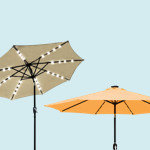









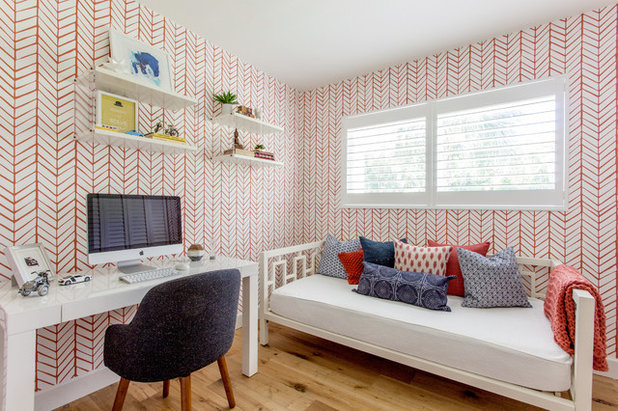









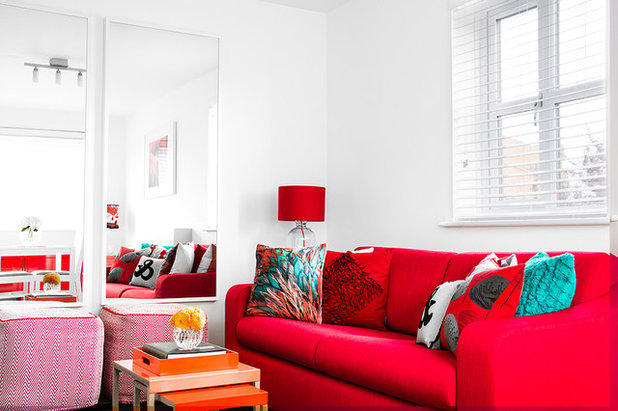


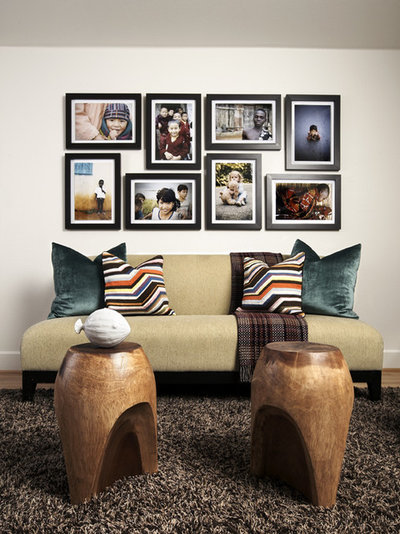





























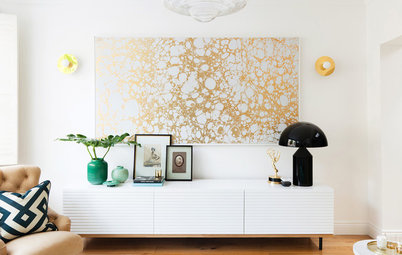
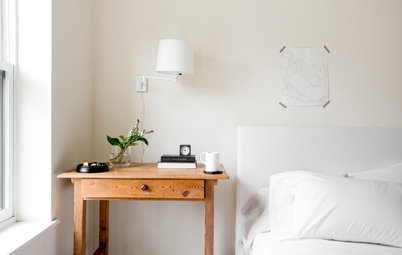

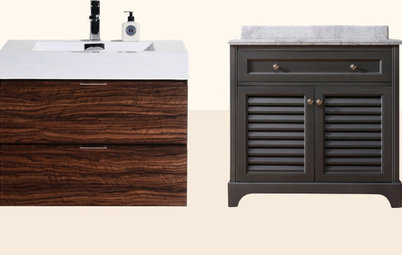

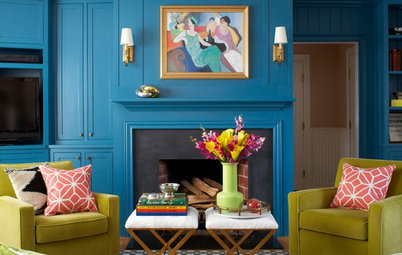



Another way I like to use wall paper besides an accent wall is with panel art. Panel art can be single or multi-paneled, but I just love the vibe it gives a room whether you go with a mural or pattern! Customization is available on our website so you can hang whatever you want AND you can order by the yard to get exactly what you need for your project.
Terrific ideas and great article!
Command picture hanging thingys are great. They don't leave a mark when removed, and they come in various sizes for heavier pictures.